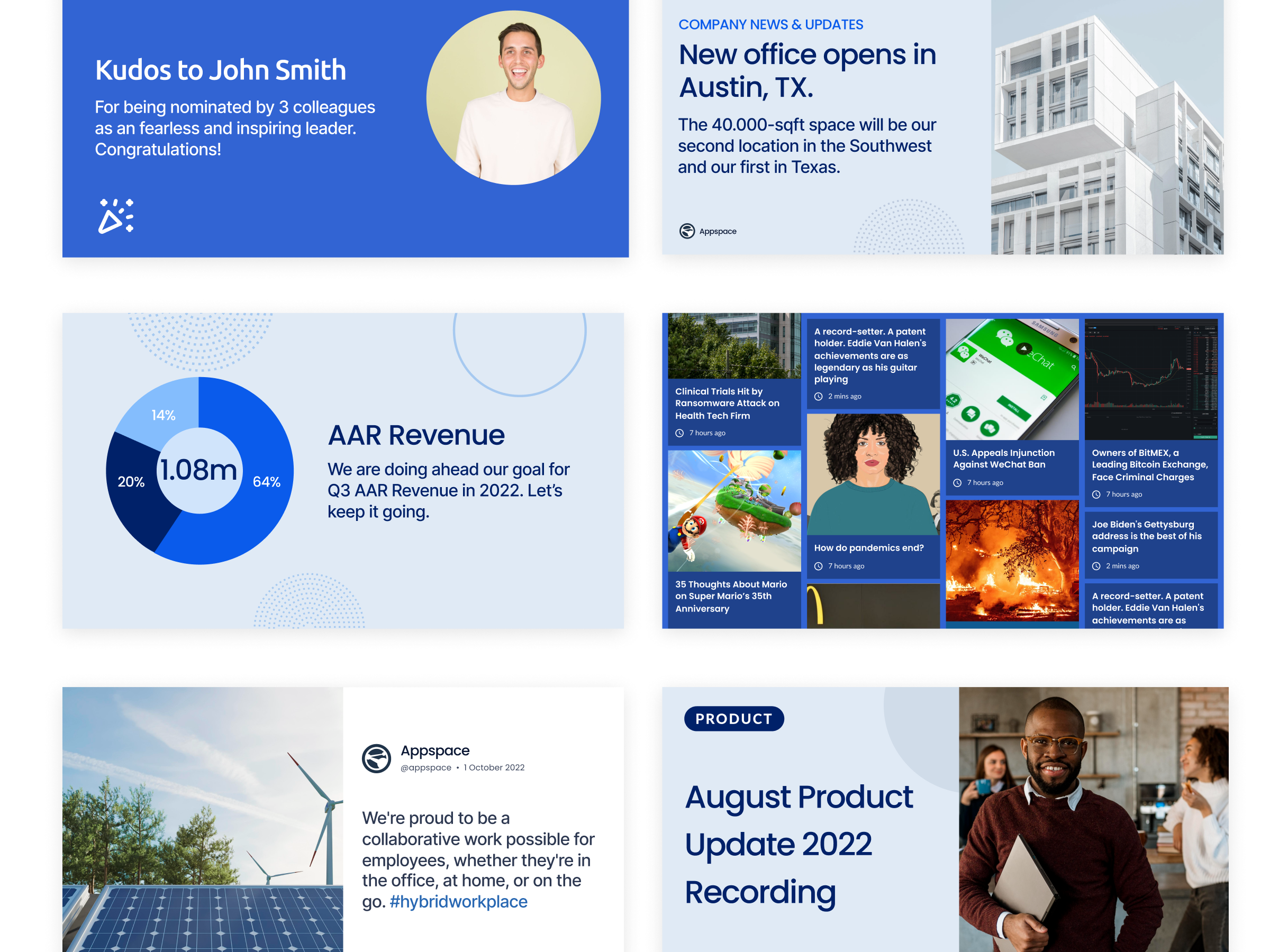Did you know that 17% of employees would recommend firing their CEO based on how the company communicates to its employees? And a whopping 80% of staff feel stressed because of ineffective workplace communication? It’s clear that something needs to change. (USA Today)

We sat down with Appspace’s Internal Corporate Communications Manager, Lauren Patton, to talk about 6 key types of internal communication. Here are her tips and best practices on what to do (and what not to do), and how to improve everyone’s stress levels.
1. Leadership communications: leaders need to be front and center
This is a big one for me. I consider helping leaders communicate effectively to be possibly the most important part of an internal communications (IC) professional’s job. Leadership has to be consistently involved in delivering information across the workplace, and they need to be front and center. I love grassroots communications where employees are encouraged to support each other, but when that’s all there is and leaders are silent, that leaves space for people to create their own narratives and make assumptions. That can hurt workplace culture and morale.
Leaders are humans, and the people they lead need to see that. I want our leaders to be approachable, authentic, and transparent, and to feel comfortable with that. And that means coaching for some. As IC professionals, one of the biggest things we have to do is show them the value of communicating regularly with the rest of the organization and help them learn how to do that effectively. Leaders also need to be the loudest cheerleaders when rolling out new initiatives, particularly when it impacts the business or employees’ roles. Leaders have got to be your earliest adopters, and their teams need to see that. For internal communications teams, that means there’s a lot of work to do to get everybody on board.
For example, we have a great employee recognition program. Team members nominate each other, and a volunteer committee of people across the organization chooses the winners for a monthly cash prize. Initially, winners got a passing announcement during Town Halls, and that was it. We weren’t getting a lot of nominations. When I joined Appspace, I pushed for more communications around the program, including more involvement from leaders. Now, every winner gets a personal phone call from one of our C-suite leaders with the good news before that same leader shares it with the rest of the organization. We proactively share the full nomination summaries for winners with leaders so they know in advance exactly who they’re talking to and why (and we also post the summaries for the rest of the company to read later on). In most workplaces, some people will never interact with a C-suite leader. Our employee recognition program makes time for our executive leaders to directly connect with team members and tell them, ‘I know who you are, I heard about you, and I want to congratulate and thank you.’ That improves morale, retention, motivation, and productivity. But creating the connection is the main point for me.
Leadership communications are crucial when you have difficult or complex messages to share. We hold quarterly Town Halls at Appspace and regular All-Hands meetings. All-Hands are more casual, all-company meetings that focus on one topic. No matter which one we’re doing, we always try to work a Q&A with leadership into those sessions to encourage open discussions between everyone in the workplace. We’ll then share the recordings on our intranet so that everyone has access no matter when or where they work.
I don’t usually do a lot of prep with leaders for Q&A. We’ll ask for questions in advance, and I may share those questions before the call so leaders have some time to think about it first, but I’m not creating talking points or scripts for them. We also allow live questions, and I don’t censor those. In either case, I want leaders’ authentic answers. When people know that they can ask hard questions and get an honest answer – not a corporate-approved answer – it creates a high level of trust across the organization.
2. Employee voice: let people share their stories on their terms
Employee-generated content is compelling. It helps people build relationships. When I can see what team members are talking about, it informs how I approach particular messages so we can proactively address issues instead of them coming to a head later. With employee voice, you should get in the practice of listening. Don’t take what they’re saying personally because whatever they talk about, good or bad, is important to them.
I am a champion for letting employees share their stories on their terms. It’s a powerful tool to bring people together and foster support and understanding. In a past job, I created an initiative that was literally called Employee Voices. It was a series on the company intranet where we would invite employees to share their stories about a particular topic. They were long-form first-hand stories where we covered heavy topics like mental health and substance use, and there was no stigma or judgment. It was always so powerful. People would comment on these stories from people they may have never interacted with otherwise and say, ‘This made me cry. I’m just so glad that you shared this’ or ‘I’ve felt the same, I’m glad I’m not alone.’ It opened doors for collaboration and internal network-building, and created a stronger sense of belonging.
3. Peer-to peer-communications: take a hands-off approach
I avoid getting too involved in peer-to-peer communications. People need to feel comfortable discussing issues and work with colleagues on their own terms. I want employees to be empowered to share information and know it’s safe to be authentic when they do.
I think where internal communications teams come into play here is coaching people on how, where, and when to deliver messages, especially when they’re communicating with people with whom there isn’t a solid relationship yet. IC can ask as a consultant to make sure they’re tying interactions back to company values. Camaraderie is one Appspace value, so I can help others consider things like: Are you approaching people or sharing information in a way that invites camaraderie, or will your approach put someone on the defensive? How can we make sure your messages are clear and get the kind of engagement or reaction you want? But I’ll leave it to them to do the actual communicating.
4. Crisis communications: plan before you need plans
I think there are two parts to consider with crisis communications: internal and external. Because for some companies, an internal crisis may hit the news. But even if it doesn’t become a headline, people talk to their peers, friends, and families. Messaging needs to be clear and consistent for both audiences.
One of the best things we can do is plan before we need plans. Creating playbook templates for different scenarios and figuring out what resources and support you’ll need internally and externally is essential. Whether it’s a security breach, a reputation risk, or weather-related incidents, having plans in place makes life easier for everyone. Because when it comes to crisis communications, it’s all about timing. How fast can you get that clear message out? Forward planning is crucial when you’ve never given it thought in advance or if you know your company has a long, complex approval process.
Think about how you’ll reach each of your employees, including those working from home, on the shop floor, and in the office. Think about what you need to say, how you will reassure and support people, and which channels or methods are most likely to reach people: is it on mobile phones via your employee app, on your intranet, on digital signage in your offices, or in public areas?
Practicing crisis communications can be useful if you have the time and resources. It helps you to think about everyone’s roles in a crisis and what processes you have or need to execute well. What do we do in this or that crisis, and how do we do it? Crisis drills can be stressful and tense at the time, but it’s easier when you have an actual situation because you’ve done this before. You’ll know what to do.
5. Culture communications: culture is everything you do and don’t do, say and don’t say
I might be the contrary voice here. But I don’t think “culture communications” exist. I believe culture is everything, and everything is culture. There’s a throughline to everything you say or don’t say, do or don’t do. When I think about culture communications, I really think of that as being weaved into all the other types of internal communications and even beyond.
I also want to point out that “culture” is often used to mean something positive, but it’s actually a neutral word. Our words and actions (or silence and inactions) shape what that word means for our teams, for better or worse.
The way leaders communicate is part of our culture. The way the company rolls out initiatives is part of our culture. The way we interact with and support our peers is part of our culture. When we’re defining the type of culture we want to build, that really should be reflected in everything else that we’re doing. It can’t be a separate category because it comes off as checking a box. It’s not genuine. It doesn’t mean anything to anyone.
Culture is tied especially to peer-to-peer and leadership communications, and your corporate values. I can coach employees on connecting things to values or approaching certain subjects so that messages are inclusive. But to send out one email to recognize Pride Month, condemn racism, or say the company believes in creating better work-life balance, and that’s the only thing that ever gets said about it? That’s not culture-building. That’s just lip service. You need actions, policies, procedures, and continued conversation, all rooted in your values, to back it up.
6. Knowledge and information communications: if you only need to know one thing…
Sharing knowledge and information, which might be really technical, is always tricky. You need to make it accessible. My trick is to give people layers of information. I like to approach communications planning with an ‘If you only need to know one thing’ mindset. Make that the goal – if I only have a few seconds to make something happen or get something across, this is it. Everything else is cake.
Something our Security team does that I love is putting a TL;DR (too long; didn’t read) at the beginning of their messages. It’s acknowledging that people aren’t going to read most of it but asks that they at least read these two or three key sentences. It keeps things to the point and saves time for those who don’t need to know every little detail but gets into the nitty gritty in the latter half for those who want or need to learn more. At the very least, we can be confident the main message got across.
Having hubs for information is essential, and that’s where a good intranet can prove its worth. If you’ve got a whole subset of employees who need to know all the technical details about something, a well-structured intranet makes it easy for them to find that information themselves. And involve your subject matter experts (SMEs). IC professionals learn a lot about everything, but we don’t understand everything intimately. We know enough to share key messages in ways that resonate and direct people to resources that can help. Getting your SMEs involved in creating and owning those pieces (and keeping them up to date) will take a lot of the stress out of your job and ensures accuracy for anything technical. And it makes so much sense. When people can find information easily, know it’s the latest, and it’s easy to read, that improves productivity because they’re not spending time combing through outdated information to find what they need.
Another thing that I’m a big proponent of is doing a tool audit. Many internal communicators have to be scrappy with their tools because, historically, there’s been a lack of investment in IC (though I think we’re seeing that change somewhat now). And other departments do the same thing. So now you’ve got five departments using five different tools to do essentially the same thing. That’s how you create silos and inefficiencies. Doing a tool audit helps determine what’s being used right now, what we can cut out, and where we can consolidate tools or expand use cases so there are fewer places to look for information. Going through that exercise makes it easier for everyone to find what they need when they need it.
That’s one of the many reasons I love leading internal communications at Appspace. The tools we’ve created to improve workplace experiences for our customers (and ourselves!), like the Appspace Intranet and Employee App, consolidate what a bunch of point products do into a single, robust platform. It’s so much simpler for everyone to share, find, and connect information across the organization, no matter who or where employees are. As an IC professional, that’s huge.
Find out more about what Appspace can do for your internal communications team.




